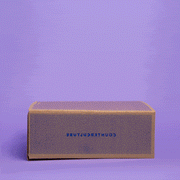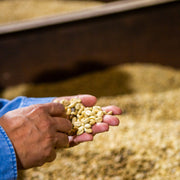Potato Defect—also known as Potato Taste Defect, or PTD—occurs in coffees from Rwanda, Western Uganda, Burundi, and the Democratic Republic of Congo. It smells and tastes exactly like what the name implies: raw potatoes.
What Is Potato Taste Defect?
Potato Taste Defect (PTD) is caused by a chemical called 2-Isopropyl 3-methoxy pyrazine (IPMP). In its strongest instances, this potato smell can be apparent in the air at the farm, in the green coffee including the cherry and parchment, as well as the roasted and brewed product. While there are ongoing, intensive efforts at the farm level to reduce the number of PTD incidences, there is currently no way to sort out the defect in the green or roasted coffee in a scalable manner.
For the specialty coffee industry in the regions affected by PTD, this defect has caused seemingly insurmountable issues at the farm level with direct consequences on the amount roasters purchase from affected regions as well as the selling power of area producers. Agronomists and biologists have proposed many theories and conducted numerous studies about the possible causes of Potato Taste Defect beginning as early as the 1950s, but currently there are no proven solutions to significantly eradicate the rate of defect.

Identifying Potato Taste Defect
There are very low, if any, visual identifiers that correlate to PTD defective seeds (or coffee beans). In fact, most defective seeds look perfectly normal to the human eye and show no visible insect damage or UV fluorescence. Therefore, unlike other defects, there is no “preventative maintenance” in processing or sorting methodologies that the producer can do to ensure a highly reduced rate of PTD.
PTD seems to be a defect solely detectable via gustation and olfaction. We have done research to better understand the defect occurrence rate in the coffees we buy, and are sharing our recommended protocols to avoid tasting the defect when brewing.
How Prevalent Is Potato Taste Defect?
In our research tracking PTD, the average occurrence rate of this defect is 1 in approximately 1550 grams in the coffees we buy. This means in every 3.3 pounds or so, the likelihood of hitting one PTD coffee bean is fairly high. It also means that the chances of experiencing potato defect in a 12 oz bag are low. Of course, there is a large element of randomness involved in this—that is just the nature of the beast.
In whole-bean coffee, there is no issue with transference. For example, if you open a bag and it smells of potato, the whole bag is not tainted. It is more than likely one defective coffee bean that simply smells very strong.
There is no known toxicity in the defect itself, and it is safe to consume, should you encounter it once brewed. However, since one defective bean can affect the taste of the resulting brew, we are sharing our recommended steps to take to avoid tasting potato.
Suggested Protocol To Avoid Tasting Potato
- When preparing to brew coffees from these regions, be sure to diligently smell the ground coffee before brewing.
- Grind your coffee in small amounts instead of grinding the whole bag at once. For home brewing, we recommend grinding <30 grams at a time. For batch brewing, we recommend grinding 100 grams at a time.
- If you only smell delicious coffee, continue brewing and enjoying these incredible coffees!
- If you are not sure, and you think you might be smelling potato, well, it is probably because you learned about PTD so your brain is telling you it is there. It might not be! Check out our Taster’s Flavor Wheel to see what else you might be tasting.
What To Do If You Smell Potato
If you smell raw potato (you’ll know!) in the grounds before brewing:
- Compost the grounds
- Purge the grinder of any remaining chaff/fines
- If possible, grind through approximately 30g of coffee that is guaranteed to not have PTD (such as a coffee from Guatemala, Colombia, etc.) as to prevent transference to the next batch of coffee
Potato Taste Defect And Counter Culture Coffee Research

At Counter Culture Coffee, we continue to purchase these coffees because, outside of this defect, they exemplify some of the best-tasting and most-dynamic coffees in the world and we believe these producers are worthy of a great market for their quality product.
We go above and beyond industry standards in evaluating the instance rate of potato defect in the coffees we buy. We completed a research study to figure out how many grams of a coffee sample it would take to achieve a 90% confidence that the number of times PTD shows up was accurate.
Currently, it is common practice for roasters, buyers, and QC people in the specialty coffee industry to evaluate only three to twenty cups before approving or rejecting a coffee from these regions. This is an issue because it is likely that coffees with a reasonable incidence rate of PTD are rejected when one cup in a very limited amount reveals the defect, and vice versa — those which have a normal, or even higher incidence rate of PTD are being approved when they do not show the defect in a limited number of cups. This decision is made regardless of the coffee’s overall quality.
The accuracy of this sample set is minimal at best: 10% accurate assuming a very generous sample size of 250 grams. Because of Potato Defect and its perceived risk (often based on minimal data), there are direct consequences on the purchases of coffees from these regions, which ultimately affects the producing and selling power of farmers. By understanding the realities of PTD in coffees from these areas and grounding these realities in data, the specialty coffee industry can have more realistic expectations of the defect’s rate. This, in turn, could create more sustainable value streams in these coffee origin countries.
According to all the grind-through data that we collected from coffees from Rwanda and Burundi over the course of a couple of years, tests revealed that you need to evaluate just about 5,600 grams of a coffee sample, or just over 12 pounds. Counter Culture sent some defective and non-defective samples to Seattle University, where chemists used their smelling machine to confirm the presence (or lack thereof) of potato defect. Our experiences with the defect and that of their machine’s were aligned, indicating that our methodology for detecting and tracking PTD is a strong one.





